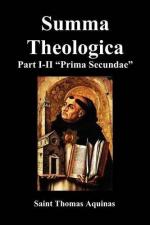one towards the other: and over the ark was a
table, called the “propitiatory,” raised
above the wings of the cherubim, as though it were
held up by them; and appearing, to the imagination,
to be the very seat of God. For this reason it
was called the “propitiatory,” as though
the people received propitiation thence at the prayers
of the high-priest. And so it was held up, so
to speak, by the cherubim, in obedience, as it were,
to God: while the ark of the testament was like
the foot-stool to Him that sat on the propitiatory.
These three things denote three things in that higher
world: namely, God Who is above all, and incomprehensible
to any creature. Hence no likeness of Him was
set up; to denote His invisibility. But there
was something to represent his seat; since, to wit,
the creature, which is beneath God, as the seat under
the sitter, is comprehensible. Again in that
higher world there are spiritual substances called
angels. These are signified by the two cherubim,
looking one towards the other, to show that they are
at peace with one another, according to Job 25:2:
“Who maketh peace in . . . high places.”
For this reason, too, there was more than one cherub,
to betoken the multitude of heavenly spirits, and
to prevent their receiving worship from those who had
been commanded to worship but one God. Moreover
there are, enclosed as it were in that spiritual world,
the intelligible types of whatsoever takes place in
this world, just as in every cause are enclosed the
types of its effects, and in the craftsman the types
of the works of his craft. This was betokened
by the ark, which represented, by means of the three
things it contained, the three things of greatest import
in human affairs. These are wisdom, signified
by the tables of the testament; the power of governing,
betokened by the rod of Aaron; and life, betokened
by the manna which was the means of sustenance.
Or else these three things signified the three Divine
attributes, viz. wisdom, in the tables; power,
in the rod; goodness, in the manna—both
by reason of its sweetness, and because it was through
the goodness of God that it was granted to man, wherefore
it was preserved as a memorial of the Divine mercy.
Again, these three things were represented in Isaias’
vision. For he “saw the Lord sitting upon
a throne high and elevated”; and the seraphim
standing by; and that the house was filled with the
glory of the Lord; wherefrom the seraphim cried out:
“All the earth is full of His glory” (Isa.
6:1, 3). And so the images of the seraphim were
set up, not to be worshipped, for this was forbidden
by the first commandment; but as a sign of their function,
as stated above.




